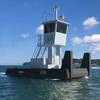Chemical Tanker Owners Seek Fleet Renewal
An easing of chemical tanker earnings in Q2 has not discouraged owners tempted to place newbuilding orders. After a period of extremely strong vessel earnings and asset valuations, an unwinding of the support that created the earnings boom has seen spot and time charter rates fall from their highs, though still remain at elevated levels.
This bifurcation of the market has seen owners tempted back to the shipyards with ordering picking up steadily from Q1 and into Q2, reports MSI in its Chemical Tankers Q2 2023 report. The slow trickle of orders has quickened despite higher costs of capital and uncertainty over future fuel technology.
The summer has brought with it an end to high one year time charter rates, freight and asset prices for chemical tankers, a rally which started in Q3 22. As MSI has previously highlighted, the high earnings enjoyed over the last year have less to do with high volume demand and more with disruptions in the tanker market stemming from the war in Ukraine and the subsequent tonnage draw from the clean petroleum products (CPP) market.
The release of swing tonnage from the CPP market has impacted one year time charter rates, with fewer deals executed over the last quarter with operators less inclined to commit to long-term charters at such high prices in a period of uncertainty. Despite spot rates softening for chemical and product tankers in recent weeks, owners have still been able to achieve healthy returns as bunker prices eased at least six months ahead of the spot market declines.
Newbuild contracting activity at the start of 2023 was initially subdued thanks to high slot costs and long lead times at shipyards; just four newbuild tankers of an aggregate 40,000dwt were contracted in the first two months of this year. Since then, there has been a notable uptick in contracting activity during Q1 in large part driven by three midsize owners placing orders for series of 18,500dwt vessels at Chinese yards.
This momentum carried over into Q2 23 and by mid-June, a further 18 chemical tankers with an aggregate 252,000dwt had been contracted. The largest vessel ordered was a 47,900dwt dual-fuel methanol carrier though the other contracts placed in the first five and a half months of this year have been for sub-19,000dwt chemical tankers.
“With product tankers continuing to split their time between the CPP market and chemical/edible trades, MSI expects earnings for product tankers to ease in H2 23 and into 2024 but remain at elevated levels,” said Bonita Nightingale, Senior Chemical Market Analyst, MSI. “Some owners are expected to react to the softening in rates by scrapping older tonnage which will support the overall sector employment rate and rates and earnings will remain above historical averages over the next year.”













